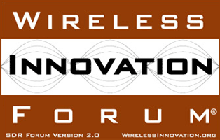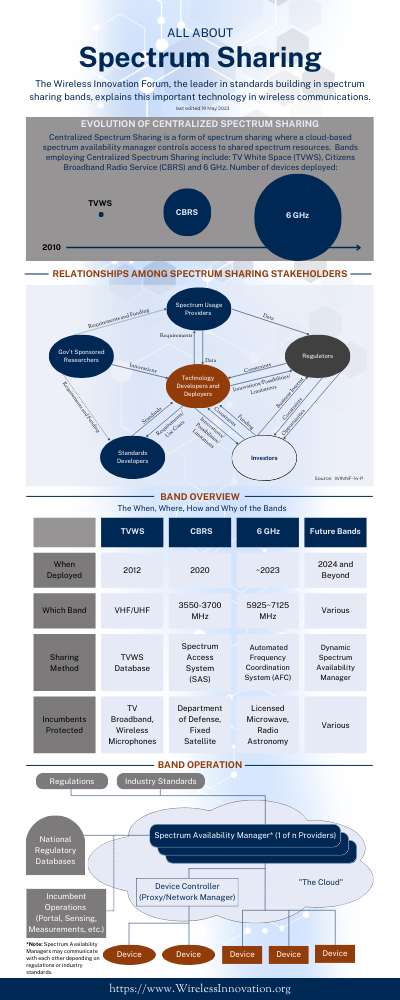- Home
- Knowledge Center
- Reports, Recommendations and Specifications
- Information Documents
- All About Spectrum Sharing Infographic
- Free Webinars
- Tech Talks
- Setting the Standard Video Blog
- Beyond the Radio Dial Video Blog
- Conference Proceedings
- Workshop Proceedings
- Springer Journals
- Market Studies
- What is the SCA?
- Issue Submissions
- Reference Implementations
- What is SDR?
- What are CR and DSA?
- About Us
- Events
- News
- Projects & Committees
- Members
- Join the Forum
|
[Return to main Advocacy Agenda page] It is the Forum’s view that the proper application of security services and mechanisms, when based on a conscientiously developed security policy formed from a defined threat model and risk assessment, can provide the security architecture and design necessary to ensure the integrity reliability and availability of our nations Emergency and Critical Communications systems. 4.1 Security Considerations The Wireless innovation forum has published a report outlining a process which identifies potential threats and vulnerabilities and leads to the development of security policies at the organizational, system and individual platform level.20 These security policies specify the criteria and measures needed for protection and mitigation of designated threats throughout the entire lifetime of a system and its component elements. The process includes identification of assets which require protection. These include but are not limited to information, security operating parameters and data, embedded software, hardware components and virtually any infrastructure component including dispatch centers, servers, routers relays, base stations and individual radio platforms. Threat and vulnerability analyses must tailor for each asset as is the risk assessment estimating the probability that any given threat/vulnerability may be realized. With this process completed then specific security measures and mitigation methods can be developed which can be applied to the design, manufacture and operation of the system and its various component elements. These security measures, methods and design requirements then form the basis of the various Organizational, System and Platform security policies which govern the design, manufacturing, operation and maintenance and decommissioning of the system and its components. 4.2 Avoid Security by Obscurity Some obvious examples of what is required to remain secret in a security framework are keys, passwords, and biometric data that provide various forms of access control. For example, if a product based its security on publicly available cryptography for which there has been no known failure, then if a key is ever compromised, simply replacing the key may return security to its original state for all transactions going forward. 21 4.3 Open Source Security Some of the most successful security techniques in information and communications technology today are based on open source approaches. For example, most web-based e-commerce transactions today use a technique called Secure Socket Layer (SSL), which is also referred to as Transport Layer Security (TLS). The specification for SSL was vetted through the open processes of the Internet Engineering Task Force. IPSEC V.4 and V.6 are examples of other security protocols, which are essential to security on the internet and are mandated for use on systems used by US Government. Thus the Forum urges that Regulators should remain neutral with respect to open source security methods. Academic inquiry and industry discussion coupled with a market test is more likely to lead to the correct outcome with respect to the open source debate than regulatory intervention. 22 4.4 Over the Air Software Reconfiguration The Wireless Innovation Forum recognizes the need for security in any download or other over the air operation of wireless devices and infrastructure. The Forum released the first report on security in 2002 and has since released three additional reports23,24,25,26. These reports cover the broad issues relating to security for wireless devices employing SDR technology to specific requirements for downloading software and software provisioning. In our latest report “Securing Software Configurable Communication Devices” specific services, methodologies and mechanisms are identified which applied in combination with others can provide the security necessary to ensure the integrity reliability and accuracy of the relevant over the air operation27. Examples of applicable Services and Mechanisms can be found in Chapter 3 of this document include the interworking of mechanisms such as access control, authentication, integrity, encryption, software version control. The applications of these services as examples in these processes are replete throughout the document including chapters 3, 6 and 7. ----- 20 Securing Software Reconfigurable Communications Devices, WINNF-08-P-0013-V1.0.0 21 SDRF Petition for Reconsideration, SDRF-07-R-0012-V0.0.0, pg2 22 Ibid, pg 4 and 5 23 Report on Issues and Activity in the Area of Security for Software Defined Radio, SDRF-02-R-0003-V0.00, 1 September 2002 24 Requirements for Radio Software Download for RF Reconfiguration, SDRF-02-S-007-V1.0.0. 13 November 2002 25 SDR System Security, SDRF-02-P-0006-V1.0.0, November 2002 26 Security Considerations for Operational Software for Software Defined Radio Devices in a Commercial Wireless Domain, SDRF-04-P- 0010-V1.0.0, 27 October 2004 27 Securing Software Reconfigurable Communications Devices WINNF-08-P-0013-V1.0.0 [Return to main Advocacy Agenda page] WINNF Advocacy Agenda WINNF-RC-0007-V1.2.0 Copyright © 2021 The Software Defined Radio Forum Inc. All Rights Reserved |



